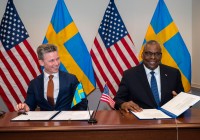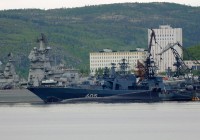
New defence agreement: Finland invites American troops to bases in Lapland
ADVERTISEMENT
The Defence Cooperation Agreement (DCA) that was signed in Washington DC on the 18th of December will significantly deepen bilateral cooperation between Finland and the USA. It supplements the country’s NATO membership, Finnish Foreign Minister Elina Valtonen explains.
“The defense cooperation agreement is an integral part of strengthening our bilateral cooperation and complements our NATO membership. In the future, I see our cooperation continuing to strengthen in the fields of security, economy and technology. Finland also considers it important that the transatlantic relationship between the EU and the United States becomes even closer,” Valtonen said ahead of today’s signing ceremony in Washington.
“Finnish bilateral relations with the USA are excellent,” she underlined in the ceremony and said that the new agreement will bring cooperation to a new level.
“This is a historical moment in our friendship,” Secretary Antony Blinken underlined. He praised the major contribution of Finland to NATO and said that Finland knows “almost better than anyone what is at stake in Ukraine.”
Present in Washington DC was also Finnish Defense Minister Antti Häkkänen.
“The agreement reflects the United States’ commitment to Finland’s security and it creates the conditions for cooperation in times of crises. Finland is not alone in defending itself, but does so as a NATO Ally and together with the United States,” Minister Häkkänen said in a statement.
He underlines that Finland has closely cooperated with the United States dates since the early 1990s, and that the new agreement “would not be possible without the long history of cooperation.”
ADVERTISEMENT
The deal was signed in the US State Department by Häkkänen and Blinken. It will have to be approved by the Finnish Parliament before adoption.
The agreement regulates US access to and use of a number of military facilities and areas across Finland, including prepositioning of defence equipment, supplies and materials, and entry and movement of US aircraft, vessels and vehicles.
The far northern Lapland region is key priority area highlighted in the agreement. Five of the 15 bases, training and storage areas included in the deal are located in Lapland.
Among them is Rovajärvi, the largest military training area in Western Europe. Rovajärvi stretches over a 1,070 square kilometres area and is used for large-scale military exercises where up to 3,500 people can participate.

Included is also the Lapland Air Command Air Base and Jaeger Brigade Garrison in Rovaniemi. The Air Command is one of Finland’s two bases for F-18 fighter jets. It will in few years house also parts of Finland’s new F-35 aircraft.
Also the military storage areas of Tervola and Veitsiluoto are highlighted in the document.

The northernmost site mentioned is the Border Guard Base in Ivalo, the small town located only about 50 kilometres from the border to Russia.
Ivalo is connected by road to the Russian Murmansk region and houses the Raja-Jooseppi cross-border point. On the Russian side of the border is located the 80th Motorised Rifle Brigade in Alakurtti, also called the Russian Arctic Brigade.
The Finnish-US agreement comes only few days after a similar agreement between Sweden and the US. Also in that agreement, far northern bases are given a high level of priority.
Unlike neighbouring Norway, Finland does not appear to limit military allied cooperation with any self-imposed restrictions. In a bid not to provoke the Soviet Union, Norway during the Cold War introduced limitations on allied military activity in its East-Finnmark region.
Although increasingly an issue of discussion, NATO allies and partners are still not allowed to take part in exercises in the East Finnmark region and also not fly military aircraft over Norwegian air space east of the Porsanger Fjord. East of the Tana Fjord, non-Norwegian fighter jets are not allowed.
The self-imposed regulations were never reciprocated on the Soviet or Russian side.
Strong voices today call on abolishment of the restrictions. The new Finnish and Swedish defence agreements with the USA make it increasingly relevant to open also East Finnmark to allied activities. On several recent occasions, allied aircraft have flown signal intelligence flights across all of Finland, but ultimately turned back south before they made it to the border to Norway.
If Norway’s restrictions were abolished, allied training and aircraft could proceed from Sweden and Finland and into the Barents Sea.

ADVERTISEMENT
The Barents Observer Newsletter
After confirming you're a real person, you can write your email below and we include you to the subscription list.








